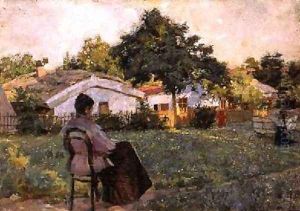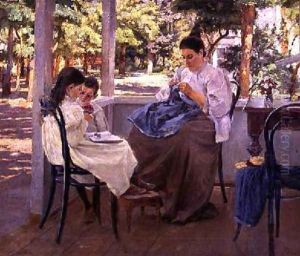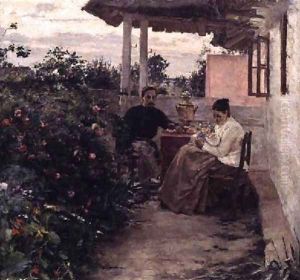Kiviak Konstantinov Kostandi Paintings
Kiviak Konstantinov Kostandi, born on May 21, 1852, in the city of Kodyma, in what is now Ukraine, was a prominent figure in Russian and Ukrainian art during the late 19th and early 20th centuries. Coming from a Greek family that had settled in the region, Kostandi's early life was steeped in the rich cultural and artistic heritage of his community. He showed an early inclination towards art, which led him to pursue formal education in this field.
Kostandi began his art education at the Odessa Drawing School before moving on to the Imperial Academy of Arts in Saint Petersburg, where he studied under the guidance of renowned Russian artists such as Pavel Chistyakov. His time at the Academy was formative, laying the foundation for his artistic style and philosophy. Kostandi was deeply influenced by the Realist movement, which sought to depict everyday life and its people with sincerity and a sense of naturalism.
After completing his education, Kostandi returned to Odessa, where he became an integral part of the local art scene. He was a founding member of the Society of South Russian Artists and played a pivotal role in the development of the art community in the region. Kostandi's work primarily focused on landscapes, portraits, and genre scenes, capturing the beauty and simplicity of rural Ukrainian life. His paintings are noted for their vibrant color palette, delicate handling of light, and empathetic portrayal of his subjects.
Throughout his career, Kostandi remained committed to educating and nurturing future generations of artists. He taught at the Odessa Art School, where his influence was felt by many students who would go on to become significant artists in their own right. Kostandi's dedication to the arts was recognized with numerous awards and honors during his lifetime.
Kiviak Konstantinov Kostandi passed away on October 31, 1921, in Odessa. His legacy lives on through his contributions to Russian and Ukrainian art, and his works are celebrated in museums and collections both in his homeland and internationally. Kostandi's life and career reflect the vibrant cultural exchange and artistic innovation of his time, making him a key figure in the history of Eastern European art.


